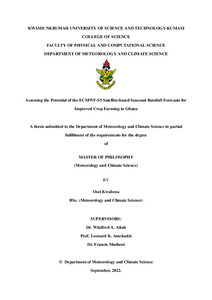| dc.contributor.author | Kwabena, O. |
| dc.date.accessioned | 2023-02-28T08:56:31Z |
| dc.date.available | 2023-02-28T08:56:31Z |
| dc.date.issued | 2022-09 |
| dc.identifier.citation | Kwabena, O. (2022). Assessing the potential of the ECMWF-S5 satellite-based seasonal rainfall forecasts for improved crop farming in Ghana. Kumasi, Ghana: Kwame Nkrumah University of Science and Technology, (99 p.). |
| dc.identifier.uri | https://hdl.handle.net/20.500.12478/8066 |
| dc.description.abstract | Forecasts of seasonal rainfall are important for the agricultural sector, particularly in nations where rain-fed agriculture is predominant. A robust agricultural system is made possible by the ability to predict seasonal rainfall with accuracy and precision. Due to the limited and sparse availability of gauge data, both satellite-based and model seasonal rainfall forecasts are beneficial for predicting seasonal rainfall. While seasonal rainfall forecasts based on models and satellites complement gauge observations, they are not without uncertainties. In order to determine their capacity to supplement observational data, this study aimed to evaluate the forecasting ability of ECMWF-S5 1 month (S51), 2 months (S52), and 3 months (S53) lead time) over Ghana. Using a statistical approach, the datasets were validated on various time scales using observed rainfall data from GMet as a reference. Their ability to determine drought periods as well as to quantify the rainfall regimes over the country’s agro-ecological zones were also evaluated using the Standardized Precipitaion Index (SPI) and rainfall Seasonality Index (SI), respectively. The results showed that the accuracy of the forecasts reduced with increasing lead time over the country and in its agro-ecological zones on temporal and spatial scales (i.e. was highest at S51 and lowest at S53). Correlation coefficient (r), Root Mean Square Error (RMSE) and Kling-Gupta Efficiency (KGE) between gauge and S51 for the entire country and different agro-ecological zones ranged between 0.85 – 0.92, 26.25 – 38.38 and 0.8 – 0.90, respectively on monthly scale, whereas on the seasonal scale, r, RMSE, and KGE ranged between 0.97 – 0.99, 4.77 – 13.03, and 0.88 – 0.97, respectively indicating that S51 performed better over the course of a season. Moreover, the study revealed that S53, as opposed to S52 and S51, was able to capture the dry periods for the entire country as well as for the various agro-ecological zones. Furthermore, S52 outperformed S51 and S53 in terms of their propensity to determine the rainfall regime over the country. The results from this study reveals that ECMWF-S5 provides reliable rainfall forecast at one month lead time that can be utilized to improve agro-advisories in Ghana. |
| dc.format.extent | 99 p. |
| dc.language.iso | en |
| dc.publisher | Kwame Nkrumah University of Science and Technology |
| dc.subject | Climate Change |
| dc.subject | Food Security |
| dc.subject | Weather Forecasting |
| dc.subject | Ghana |
| dc.title | Assessing the potential of the ECMWF-S5 satellite-based seasonal rainfall forecasts for improved crop farming in Ghana |
| dc.type | Thesis |
| cg.contributor.affiliation | Kwame Nkrumah University of Science and Technology |
| cg.contributor.affiliation | International Institute of Tropical Agriculture |
| cg.coverage.region | Africa |
| cg.coverage.region | West Africa |
| cg.coverage.country | Ghana |
| cg.coverage.hub | Eastern Africa Hub |
| cg.identifier.bibtexciteid | KWABENA:2022 |
| cg.authorship.types | CGIAR and developing country institute |
| cg.iitasubject | Climate Change |
| cg.iitasubject | Food Security |
| cg.iitasubject | Meteorology and Climatology |
| cg.notes | IITA supervisor: Dr F. Muthoni |
| cg.publicationplace | Kumasi, Ghana |
| cg.accessibilitystatus | Limited Access |
| cg.reviewstatus | Internal Review |
| cg.usagerightslicense | Copyrighted; all rights reserved |
| cg.targetaudience | Scientists |
| cg.futureupdate.required | No |

